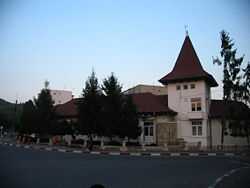Boldești-Scăeni
| Boldeşti-Scăeni | ||
|---|---|---|
| Town | ||
 | ||
| ||
 | ||
| Coordinates: 45°1′48″N 26°1′48″E / 45.03000°N 26.03000°ECoordinates: 45°1′48″N 26°1′48″E / 45.03000°N 26.03000°E | ||
| Country |
| |
| County | Prahova County | |
| Status | Town | |
| Government | ||
| • Mayor | Constantin Bucuroiu (PSD) | |
| Population (2002) | ||
| • Town | 11,485 | |
| • Urban | 10,433 | |
| Time zone | EET (UTC+2) | |
| • Summer (DST) | EEST (UTC+3) | |
Boldeşti-Scăeni (Romanian pronunciation: [bolˈdeʃtʲ skəˈjenʲ]) is a town in Prahova County, southern Romania, with a population of 11,485 as of 2002. Located about 15 km north of Ploieşti, it is an important oil-extraction center.
History
| Historical population | ||
|---|---|---|
| Year | Pop. | ±% |
| 1977 | 9,681 | — |
| 1992 | 11,757 | +21.4% |
| 2002 | 11,505 | −2.1% |
| 2011 | 10,811 | −6.0% |
| Source: Census data | ||
The town was created in 1968 by the unification of two neighbouring communes, Boldeşti and Scăeni. One village, Seciu, is administered by the town.
The phalanstère
Scăeni was the location of the only attempt to create a Charles Fourier-type phalanstère in Romania. In 1835, Theodor Diamant, a utopian socialist who had met Fourier in Paris, created the phalanstère, named The Agronomy and Manufacturing Society, on a patch of land provided by Emanoil Bălăceanu, a local land-owner. The Wallachian authorities saw this enterprise as a threat and took a stand against it. Therefore, the phalanstère was disbanded in 1836, a year and a half after it came into existence, with Diamant and Bălăceanu sent into exile.[1]
World War II
During World War II, the area was extensively bombed, as part of Operation Tidal Wave. Air-raid shelters can still be found on the wooded hills around Boldeşti.
Coat of arms
The coat of arms of Boldeşti-Scăeni depicts a thistle (in Romanian, scai or scaiete) which refers to the name of the old Scăeni commune, as well as a grape, which represents the vineyards on the Seciu hills.[2] The shaking hands is a reminder of the 19th century Scăieni phalanstère experiment,[2] but could also refer to the 1968 union of the Boldeşti and Scăieni communes.

Economy
The town's economy revolves around oil-extraction as well as winemaking. Almost half of the town's surface is cultivated with vine. The Seciu winecellars are located in the direct vicinity of Boldeşti.
Industry developed in the town after 1968, with a glass factory open in Scăeni. Many people who live in Boldeşti-Scăeni also work in the neighbouring city of Ploieşti.
Trivia
The utopian experiment by Theodor Diamant was featured in the movie "Falansterul" ("The Phalanstere"), directed by Savel Stiopul in 1979.
Notes
References
- (Romanian) Scrisori către Vasile Alecsandri: Teodor Diamant (Letters to Vasile Alecsandri: Teodor Diamant), from wikisource.
- (Romanian) Boldeşti-Scǎieni: Monograph of Boldeşti-Scǎieni, (by Cristian Petru Bǎlan, Ed. Premier, 2007), from wikisource.
- (Romanian) Romanian Government Decision no. 1697/2004, retrieved from legislatie.just.ro on 27 August 2007
| Wikimedia Commons has media related to Boldeşti-Scăieni. |

